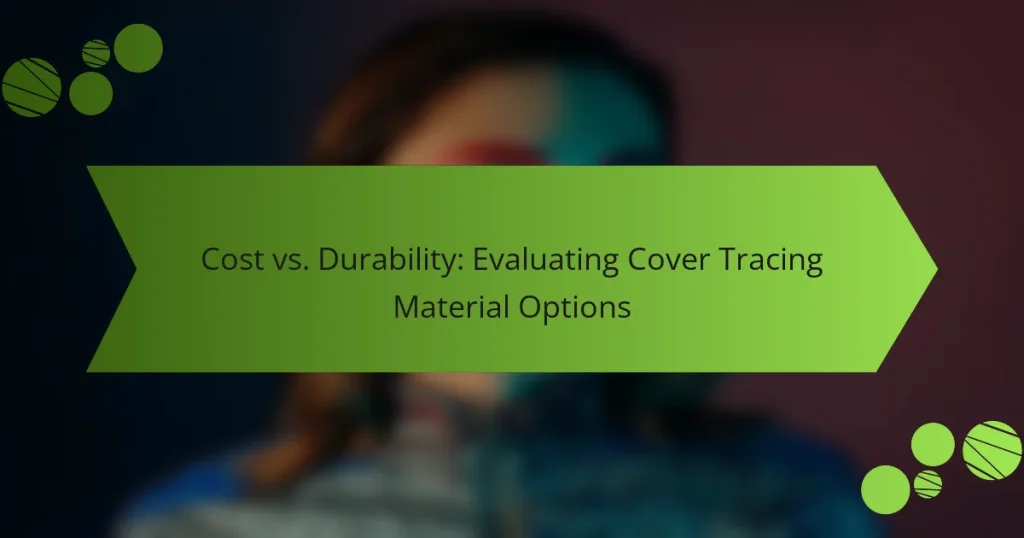When selecting cover tracing materials, balancing cost and durability is crucial for optimal performance and financial efficiency. Options like polyethylene, polypropylene, and vinyl provide varying degrees of affordability and resilience, catering to different needs. By evaluating these trade-offs, you can make informed choices that minimize long-term expenses while ensuring the material meets your application requirements.

What are the best cover tracing materials for cost-effectiveness?
The best cover tracing materials for cost-effectiveness typically include polyethylene, polypropylene, and vinyl. Each material offers a unique balance of affordability and durability, making them suitable for various applications.
Polyethylene options
Polyethylene is a widely used cover tracing material due to its low cost and decent durability. It is lightweight and resistant to moisture, making it ideal for temporary applications or environments where exposure to water is a concern.
When selecting polyethylene, consider the thickness and density, as these factors can significantly impact its lifespan. Thicker options may cost more upfront but can provide better long-term value.
Polypropylene benefits
Polypropylene is another excellent choice for cover tracing, known for its higher tensile strength compared to polyethylene. This material is more resistant to tearing and can withstand harsher conditions, making it suitable for more permanent installations.
While polypropylene may be slightly more expensive than polyethylene, its durability often justifies the additional cost. It is particularly effective in environments where chemical exposure is a concern.
Vinyl durability
Vinyl is recognized for its exceptional durability and resistance to wear and tear. It offers a longer lifespan than both polyethylene and polypropylene, making it a solid investment for applications requiring longevity.
However, vinyl tends to be the most expensive option among the three materials. If budget allows, its durability can lead to lower replacement costs over time, especially in high-traffic areas.
Cost comparison of materials
When comparing costs, polyethylene typically ranges from low to moderate prices, making it the most budget-friendly option. Polypropylene falls in the mid-range, offering a balance between cost and durability.
Vinyl, while pricier, can be justified by its long-lasting nature. A rough cost comparison might look like this:
- Polyethylene: $0.10 – $0.50 per square foot
- Polypropylene: $0.50 – $1.00 per square foot
- Vinyl: $1.00 – $2.00 per square foot
Ultimately, the choice of material should align with the specific needs of your project, considering both initial costs and long-term durability.
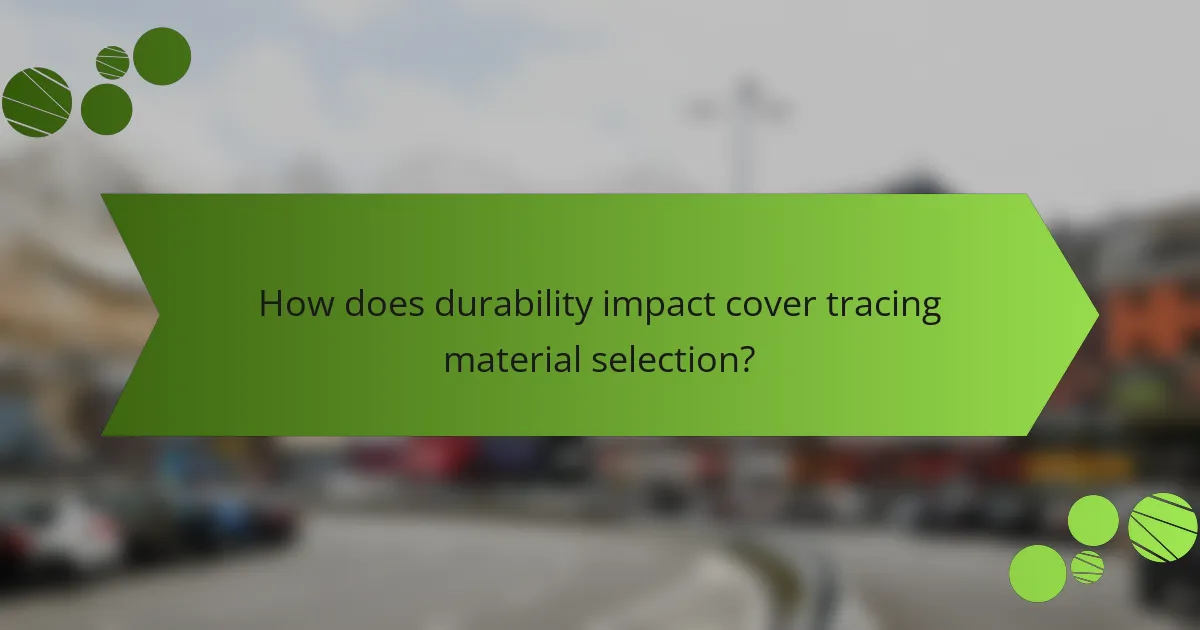
How does durability impact cover tracing material selection?
Durability significantly influences the selection of cover tracing materials, as it determines how well the material can withstand wear, environmental conditions, and usage over time. Choosing a durable material can lead to lower replacement costs and better performance in various applications.
Longevity of polyethylene
Polyethylene is known for its impressive longevity, often lasting several years under normal conditions. Its resistance to moisture and chemicals makes it suitable for outdoor applications, where exposure to elements can degrade other materials.
When selecting polyethylene, consider the thickness and density, as these factors directly affect its lifespan. Thicker polyethylene can provide better durability, especially in high-impact environments.
Resistance of polypropylene
Polypropylene offers excellent resistance to fatigue and stress, making it a durable choice for cover tracing. It can withstand a wide range of temperatures and is less likely to crack or break compared to other materials.
For applications requiring flexibility and strength, polypropylene is often preferred. Its lightweight nature also contributes to ease of handling and installation, which can save time and labor costs.
Weathering effects on vinyl
Vinyl can be susceptible to weathering, which may affect its durability over time. Prolonged exposure to UV light and extreme temperatures can lead to fading, brittleness, and cracking.
To enhance the durability of vinyl, consider using UV-resistant additives or coatings. Regular maintenance, such as cleaning and protective treatments, can also prolong its lifespan and maintain its appearance.
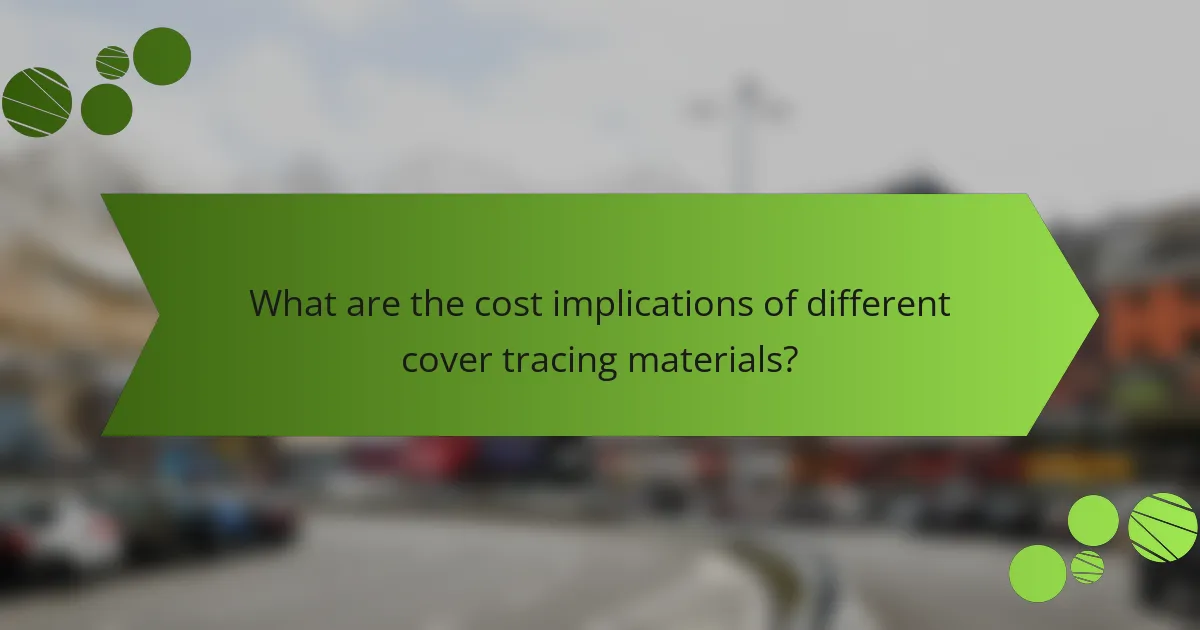
What are the cost implications of different cover tracing materials?
The cost implications of various cover tracing materials can significantly impact both initial expenditures and long-term financial planning. Understanding the trade-offs between cheaper options and more durable materials is essential for making informed decisions.
Initial investment analysis
When evaluating cover tracing materials, the initial investment varies widely based on the type of material chosen. For instance, basic plastic covers may cost around $1 to $3 per unit, while high-quality vinyl or specialized materials can range from $5 to $15 each. It’s crucial to assess not just the upfront cost but also the expected lifespan of the material.
Consider the specific requirements of your project, such as environmental conditions and usage frequency, as these factors will influence the initial investment. Cheaper materials may seem appealing, but they often require more frequent replacements, which can negate any savings.
Long-term savings with durable materials
Investing in durable cover tracing materials can lead to significant long-term savings. While the upfront cost is higher, these materials typically last longer and require less frequent replacement, reducing overall expenditure over time. For example, a durable cover might last five to ten years, whereas a cheaper alternative may need replacing every one to two years.
Additionally, durable materials often provide better protection against wear and environmental factors, which can lead to fewer maintenance costs. This means that, despite a higher initial investment, the total cost of ownership can be lower with more robust options.
Cost breakdown of installation
The cost of installation varies depending on the complexity of the project and the materials used. Basic installations for inexpensive covers may cost around $50 to $100, while more complex setups for durable materials can range from $200 to $500 or more, depending on labor and additional components required.
It’s essential to factor in both material and labor costs when budgeting for installation. Hiring experienced professionals can ensure that durable materials are installed correctly, which can extend their lifespan and effectiveness. Always obtain multiple quotes to find the best value for your specific needs.
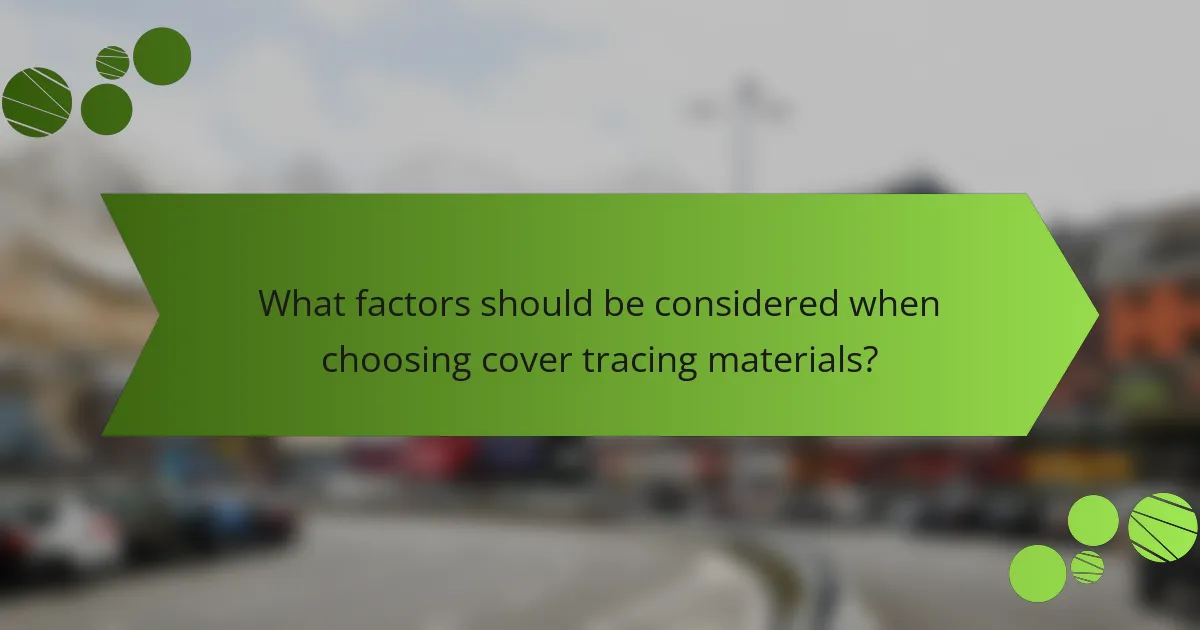
What factors should be considered when choosing cover tracing materials?
When selecting cover tracing materials, it is essential to evaluate factors such as environmental conditions, usage frequency, and maintenance requirements. These considerations will help ensure that the chosen material meets performance expectations and durability needs.
Environmental conditions
Environmental conditions significantly influence the longevity and effectiveness of cover tracing materials. Factors such as temperature fluctuations, humidity levels, and exposure to sunlight can degrade materials over time. For instance, materials exposed to high UV radiation may require UV-resistant properties to prevent fading and brittleness.
Consider the specific environment where the materials will be used. For outdoor applications, materials that can withstand moisture and temperature extremes are crucial. In contrast, indoor environments may allow for a wider range of material options.
Usage frequency
The frequency of use directly impacts the durability requirements of cover tracing materials. Materials that will be used daily need to be more robust and resistant to wear and tear compared to those used occasionally. For example, a cover tracing material used in a busy industrial setting will require higher durability than one used in a low-traffic office.
Assess the expected load and stress on the materials. If the material will be frequently handled or subjected to abrasion, opt for thicker, more resilient options to extend its lifespan.
Maintenance requirements
Maintenance requirements are a crucial consideration when choosing cover tracing materials. Some materials may require regular cleaning or specific care to maintain their appearance and functionality. For instance, materials that are easy to clean and resistant to staining can save time and effort in upkeep.
Evaluate the long-term costs associated with maintenance. A lower-cost material may end up being more expensive if it requires frequent replacement or extensive care. Aim for a balance between initial cost and ongoing maintenance to ensure overall value.
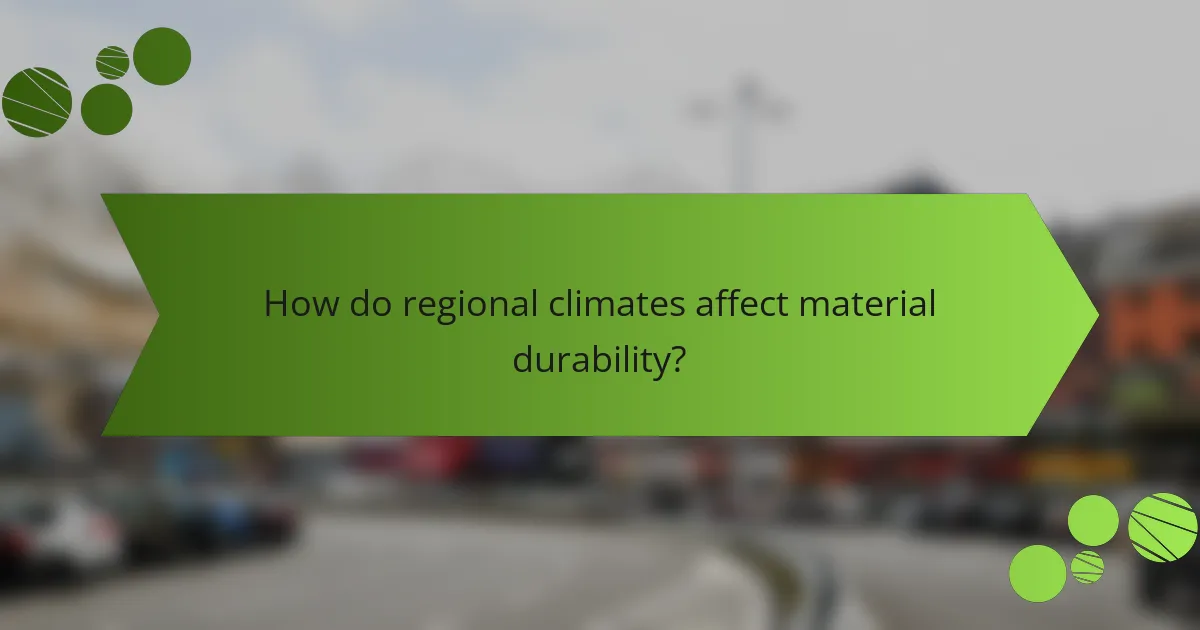
How do regional climates affect material durability?
Regional climates significantly influence the durability of cover tracing materials. Factors such as humidity and temperature variations can lead to different wear and tear rates, affecting the longevity and performance of these materials.
Impact of humidity on materials
Humidity levels can cause materials to absorb moisture, leading to swelling, warping, or degradation over time. For instance, materials like wood and certain plastics are particularly susceptible to damage in high-humidity environments.
In contrast, low-humidity conditions may lead to cracking or brittleness in materials, especially those that are not designed to withstand such dryness. Selecting materials with appropriate moisture resistance is crucial for ensuring durability in specific climates.
Temperature variations and material performance
Temperature fluctuations can affect the structural integrity of materials. Extreme heat may cause some plastics to soften or deform, while cold temperatures can make materials brittle and prone to breaking. For example, rubber may lose elasticity in colder climates, impacting its performance.
When evaluating materials, consider their thermal expansion properties and how they react to temperature changes. This is especially important in regions with significant seasonal temperature shifts, where materials need to withstand both heat and cold without failing.

What are the emerging trends in cover tracing materials?
Emerging trends in cover tracing materials focus on sustainability, performance, and adaptability. Innovations are leading to the development of materials that not only enhance durability but also minimize environmental impact.
Innovations in biodegradable materials
Biodegradable materials are gaining traction as a sustainable alternative in cover tracing. These materials break down naturally over time, reducing landfill waste and environmental pollution. Common examples include polylactic acid (PLA) and polyhydroxyalkanoates (PHA), which are derived from renewable resources.
When selecting biodegradable options, consider their decomposition rates and performance characteristics. Some biodegradable materials may not withstand harsh conditions as well as traditional plastics, so it’s essential to evaluate their suitability for specific applications. Look for certifications that indicate compliance with environmental standards, such as ASTM D6400 or EN 13432.
To maximize the benefits of biodegradable materials, ensure proper disposal methods are in place. Composting facilities or industrial composting systems can effectively break down these materials, whereas improper disposal may negate their environmental advantages. Always check local regulations regarding biodegradable waste management to ensure compliance.
